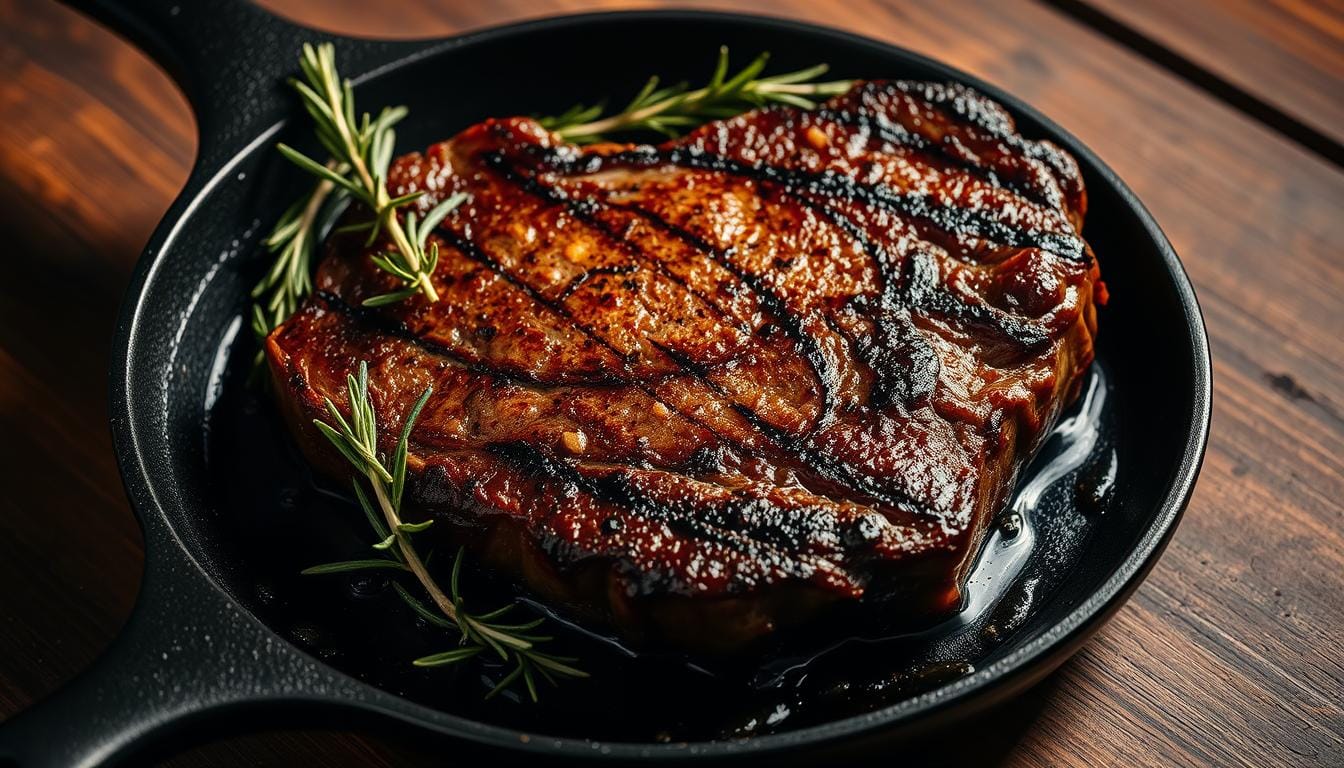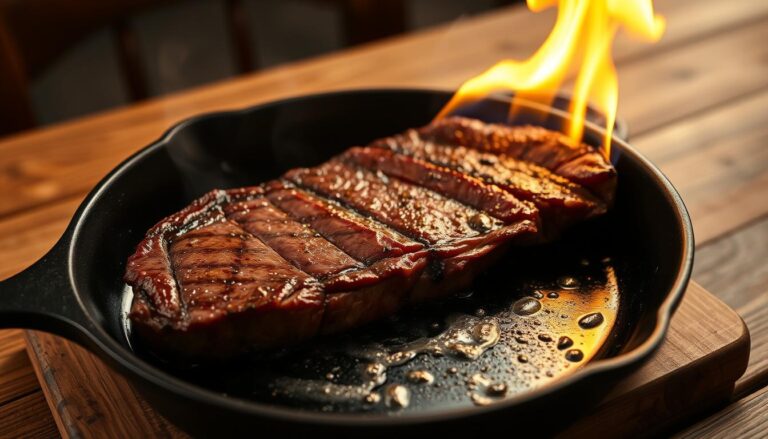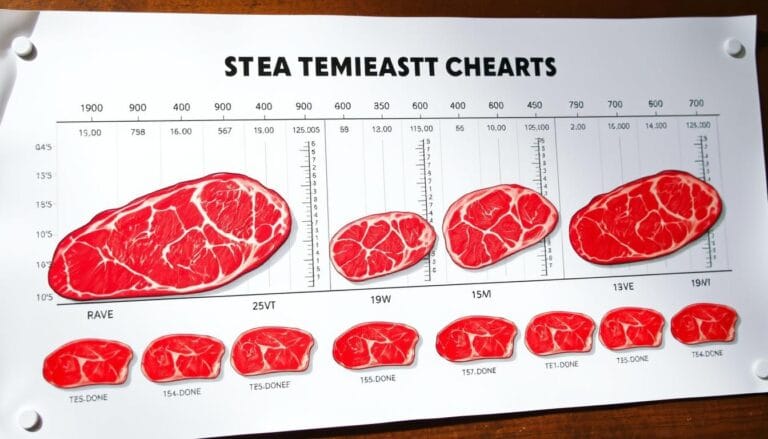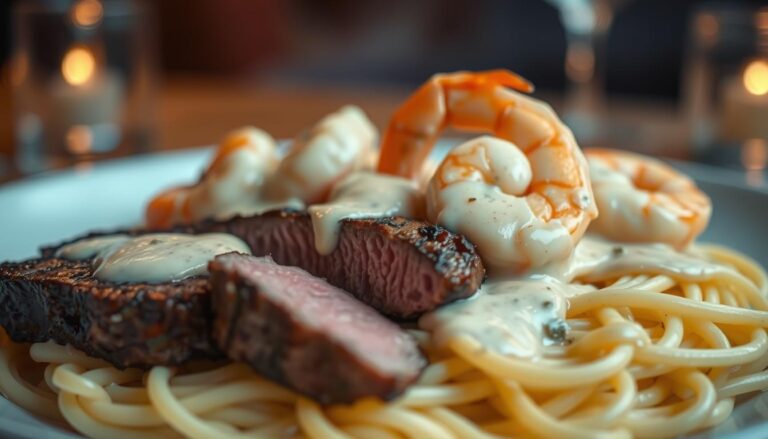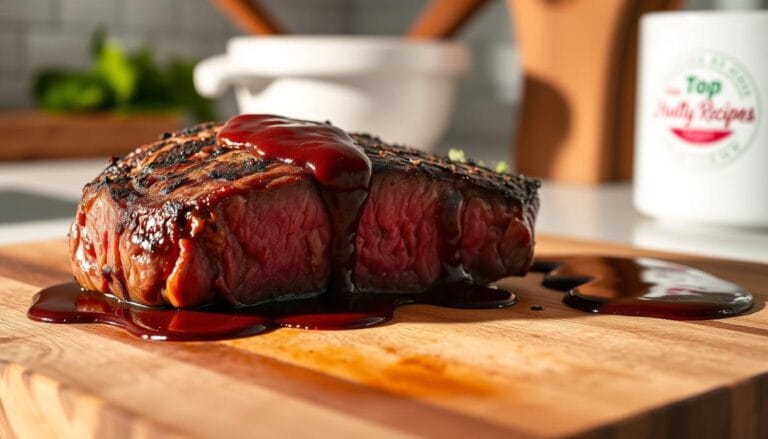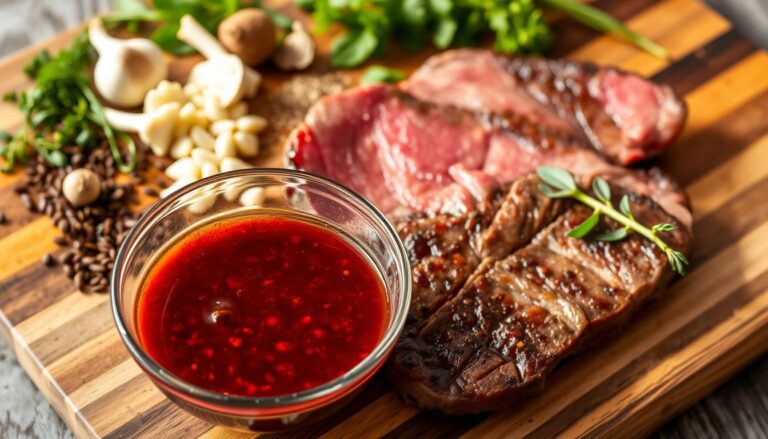Steak Internal Temp : Rare to Well Done Made Easy
Table of Contents
Steak Internal Temp : Rare to Well Done Made Easy
Get ready to improve your cooking skills by learning how to cook beef to perfection. Finding the perfect balance between juicy and done can be tricky. But with the right tips, you’ll make delicious steaks every time.
Cooking the perfect steak takes practice and patience. By learning the exact temperatures and techniques, you’ll make steaks that everyone will love.
Key Takeaways
- Understanding the ideal temperature for medium well beef
- Selecting the right cuts of beef for optimal flavor and texture
- Using proper tools and techniques for cooking beef
- Achieving a balance between juiciness and doneness
- Enhancing your culinary skills with practice and patience
Understanding Beef Doneness Levels
Knowing the different levels of beef doneness is key to a great meal. The doneness of beef is mainly based on its internal temperature. This is more reliable than cooking time or how it looks.
The Importance of Cooking Temperature
Cooking temperature is key because it changes the beef’s texture and taste. The internal temperature of steak is the best way to check doneness. The USDA says there are safe internal temperatures, but people like different levels.
The cooking temperature for beef goes from rare (120-125°F) to well-done (160°F+). Beef medium well temp is between 150-155°F. Each temperature gives beef different textures, colors, and tastes.
| Doneness Level | Internal Temperature (°F) | Description |
|---|---|---|
| Rare | 120-125 | Red and juicy, with a warm red center. |
| Medium Rare | 130-135 | Pink throughout, with a hint of red in the center. |
| Medium | 140-145 | Partially pink, with a hint of pink in the center. |
| Medium Well | 150-155 | A slight hint of pink in the center, mostly cooked through. |
| Well Done | 160+ | Fully cooked, with no pink color remaining. |
How Temperature Affects Flavor and Texture
Temperature changes beef’s flavor and texture in many ways. As beef cooks, proteins change and moisture moves out. At lower temperatures, beef stays juicier.
At higher temperatures, beef gets firmer as more moisture is lost. The beef medium well temp is a good balance. It has rich flavors and not too dry.
The Maillard reaction happens when cooking at high heat. It creates many flavor compounds that make beef taste special. Knowing how temperature affects flavor and moisture helps you cook beef just right.
What is Medium Well?
Medium well doneness is about a specific temperature and visual signs. It’s all about finding the right balance between juicy and well-cooked beef.
Defined Temperature for Medium Well Beef
For medium well beef, the internal temperature should hit 150-155°F (65-68°C). This temperature makes the beef firmer than medium or medium rare. Remember, the beef might get 5-10°F hotter after it’s removed from heat. So, chefs often take it off the heat when it’s 145-150°F.
Understanding the temperature range is key. For example, knowing what temp is a medium rare steak (usually 130-135°F) helps you see the difference. Medium well beef keeps about 25-30% of its moisture, finding a good balance between juicy and cooked.
Visual Indicators of Doneness
Temperature is precise, but visual signs help too. Medium well beef has a mostly brown inside with a bit of pink in the middle. The outside should have a caramelized crust and clear grill marks if grilled.
- The juices that come out when cut are mostly clear with a little red.
- When pressed, medium well beef feels firm but doesn’t spring back much.
- Color alone can be tricky, so always check with temperature and visual signs.
By using both temperature and visual cues, you’ll get better at knowing what medium well beef looks and feels like. This makes you more confident in your cooking.
Choosing the Right Cut of Beef
Choosing the right cut of beef is key for a perfect beef medium well temp. The cut you pick can greatly affect the tenderness and taste of your dish.
Best Cuts for Medium Well Cooking
For medium well cooking, you need cuts with moderate to high fat content. This fat keeps the beef juicy, even when it’s cooked a bit longer.
- Ribeye: Its marbling makes it moist and flavorful at medium well temperatures.
- New York Strip: It has a good balance of tenderness and fat, making it easy to cook to medium well.
- Top Sirloin: Leaner, but can be tender when cooked to medium well with the right preparation.
- Flat Iron Steaks: From the chuck area, these steaks have enough fat to stay tender.
Cuts like T-bone and porterhouse steaks are tricky because of their mix of tenderloin and strip. But, they can be great if cooked carefully. On the other hand, very lean cuts like filet mignon or tenderloin might get dry at medium well. But, their tenderness helps make up for it.
Preparing Cuts for Optimal Results
Getting the right beef medium well temp starts with proper preparation. Bring your beef to room temperature 30-45 minutes before cooking. This helps it cook evenly.
For steaks, dry the surface with paper towels to help with browning. Try a dry brine by salting the meat 1-24 hours before cooking. Refrigerate it uncovered to keep moisture in during cooking.
- For thicker cuts, consider butterflying or pounding them to a uniform thickness for even cooking.
- Tying roasts with kitchen twine helps them cook evenly by creating a uniform shape.
- Using a two-zone cooking method, like grilling or roasting, lets you sear first and then finish at a lower temperature for better control.
For leaner cuts, a marinade with acid (like lemon juice or vinegar) and oil can tenderize and add moisture. Or, wrapping leaner cuts in bacon can add fat and flavor that might be lost at medium well temperatures.
Cooking Methods for Medium Well Beef
To get the perfect medium well beef, you need to know how to cook it right. Different ways of cooking, like grilling or oven roasting, give you different results. Choose the method that fits your taste and the beef you have.
Grilling Techniques for Perfect Medium Well
Grilling is great for beef, adding a smoky taste and a nice char. Start with a two-zone fire on your grill. Sear the beef for 2-3 minutes on each side to get a tasty crust. Then, move it to the cooler side to cook until it’s 145-150°F inside.
For thicker cuts, try the reverse sear. Cook it on the cooler side until it’s about 135°F, then sear it quickly over high heat.
Tips for Grilling:
- Keep the grill lid closed during indirect cooking to maintain a consistent temperature.
- Avoid constantly flipping or moving the meat to allow for proper crust formation.
- Rotate the beef once halfway through each side’s cooking time to create attractive crosshatch grill marks.
Oven Roasting Tips for Even Cooking
Oven roasting is perfect for even cooking of larger beef cuts. Preheat your oven to 275-325°F for roasts or 350-375°F for steaks. Before roasting, sear the beef in a hot skillet to add flavor. Use a thermometer to check the internal temperature, removing it when it’s 145-150°F.
Benefits of Oven Roasting:
- Allows for more even cooking from edge to center.
- Reduces the temperature gradient between the exterior and interior.
- Enables you to achieve a tender and juicy texture.
Pan-Searing for Flavor and Texture
Pan-searing is great for a flavorful crust and medium well beef. Use a heavy skillet, like cast iron, and heat it over medium-high. Pat the beef dry before cooking to help it brown better. Sear for 4-5 minutes on each side, then reduce the heat for thicker cuts until it’s 145-150°F inside.
Enhancing Flavor:
- Add butter, garlic, and fresh herbs to the pan during the final minutes of cooking.
- Use the basting technique by spooning the aromatic butter over the meat.
- For very thick steaks, finish cooking in a preheated oven after searing.
Using a Meat Thermometer
Getting your beef just right can be tricky. But, a meat thermometer makes it easy. It helps you get a medium well steak or any other doneness level with precision.
Why You Need One for Precision
Many people ask what temp is a medium rare steak. The answer is 130-135°F. But, getting any doneness, like medium well at 150-155°F, is hard without a thermometer. Visual cues can be wrong because of meat color, lighting, and how we see things.
A good meat thermometer gives you exact readings. Digital thermometers give fast, accurate results. Leave-in probe thermometers let you watch the temperature without opening the oven or grill. This way, you avoid overcooking and ensure food safety.
How to Properly Use a Meat Thermometer
Learning to use a meat thermometer is key for perfect internal temp steak. Choose the right thermometer for your cooking method. Instant-read digital thermometers are good for most, while leave-in probe thermometers are best for oven roasting or smoking.
Make sure your thermometer is calibrated right. Most can be tested in ice water (should read 32°F) and adjusted if needed. When you measure, put the probe in the thickest part of the meat, away from bones, fat, and cooking surfaces.
- For thin cuts like steaks, insert the thermometer horizontally from the side.
- For roasts or thicker cuts, insert the probe at least 2 inches deep into the center.
- Take multiple readings in different locations if the cut is irregularly shaped.
For medium well readings (150-155°F), check the temperature 5-10°F before your target. This is because the meat will cook a bit more after it’s taken out. Always clean your thermometer well between uses to avoid contamination.
Letting Your Meat Rest
After cooking your beef to the perfect medium steak temperature, it’s time to let it rest. This step is key to the meat’s final texture and juiciness.
The Benefits of Resting Beef
Resting beef is a must after cooking. It affects the meat’s texture, juiciness, and internal temperature. When you cook, heat tightens the meat’s fibers, pushing moisture to the center.
When you cut into the meat right away, this moisture flows out. But resting lets the fibers relax and soak up some of this moisture. This makes the meat juicier.
Resting also allows for carryover cooking. This means the meat’s internal temperature rises by 5-10°F. So, remove the beef when it’s 5-10°F below your target. For medium well, that’s 140-145°F.
Timing Your Rest Period Correctly
The right resting time depends on the beef’s size and thickness. A general rule is 5 minutes per inch. So, a 1-inch steak rests for 5 minutes, while a large roast might need 20-30 minutes or more.
To rest beef, put it on a warm plate or cutting board. Cover it loosely with foil to keep it warm. This prevents the crust from getting soggy.
Use this time to get your sauces ready or finish side dishes. If you’re worried about the meat cooling too much, you can warm it in a 170°F oven for a few minutes. But this might make it cook a bit more.
Flavor Enhancements for Medium Well Beef
To make your medium well beef taste better, try adding flavor enhancements. When cooking to beef medium well temp, the right methods can greatly improve taste and texture.
Marinades and Seasonings
Marinades add flavor and keep meat moist. For medium well beef, use marinades with vinegar or citrus juice and oil. Good marinades mix balsamic vinegar, olive oil, garlic, and rosemary. Let steaks marinate for 2-4 hours, and bigger cuts for 4-24 hours in the fridge.
For dry seasonings, salt is key. Use it 45 minutes before cooking for better flavor or right before for a tasty crust. Black pepper, when coarsely ground, adds depth during searing. You can also make a spice rub with smoked paprika, garlic powder, and herbs like thyme or oregano.
The Role of Searing in Flavor Development
Searing is vital for flavor, no matter the doneness. The Maillard reaction happens when meat is seared, creating new flavors. This starts at 285°F and gets better with higher heat.
To sear well, heat your pan to 400-450°F before adding meat. Dry the beef with paper towels to help it brown. Don’t move the meat too much; let it sear for 2-3 minutes before flipping.
For medium well, you can sear first and then cook at a lower heat. Or, try the reverse sear method. This slowly cooks the meat to 135°F before searing. The reverse sear can make the meat more evenly cooked and flavorful.
Common Mistakes to Avoid
To get your beef just right, avoid common mistakes. The goal is to hit the perfect internal temp steak without overcooking or undercooking.
It’s important to keep an eye on the medium steak temperature. The difference between perfectly cooked and overcooked is very small.
Overcooking: Signs and Consequences
Overcooking can ruin your meal. Overcooked beef looks gray-brown all the way through, with no pink left. It might even get too dark or burnt.
- It feels tough and dry because the proteins contract, pushing out moisture.
- The taste suffers, losing its rich flavor and sometimes becoming bitter.
To avoid overcooking, use a meat thermometer. Take the beef off the heat 5-10°F before your target. This helps with carryover cooking.
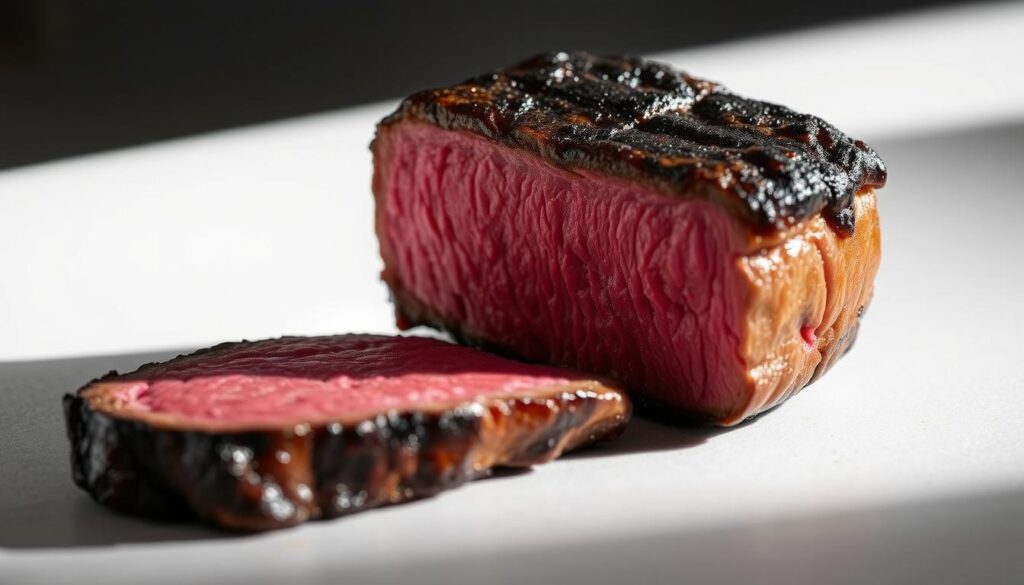
Skipping the Resting Period
Not resting the beef is a big mistake. When cooked, muscle fibers contract, pushing juices to the center.
Skipping the rest means these juices spill out when you cut into the meat. They should stay inside, making the beef juicy and flavorful.
- Let your beef rest for at least 5 minutes per inch of thickness, covered loosely with foil.
- This simple step greatly improves your medium well beef’s quality, without needing extra ingredients or tools.
Side Dishes that Pair Well with Medium Well Beef
Choosing the right side dishes can make your meal better. It’s all about finding flavors and textures that match the beef.
Popular Starch Options
Starches like mashed potatoes are a great match for medium well beef. They offer a creamy texture that goes well with the beef’s firmness. Adding roasted garlic, horseradish, or aged cheddar can make it even better. Rice pilaf with toasted almonds or wild rice with mushrooms add nutty and earthy flavors.
Roasted potatoes with herbs like rosemary and thyme are also excellent. They have a crispy outside and a fluffy inside. For a fancy look, try hasselback potatoes. They’re thinly sliced but stay connected, perfect for browning. Risotto with mushrooms, parmesan, or truffle oil is great for an Italian meal.
Fresh Vegetables for Balance
It’s important to balance your meal with fresh vegetables. They add color, texture, and nutrients. Roasted vegetables are a good choice because they caramelize and taste richer. Try brussels sprouts with bacon, carrots with honey, or a mix of root vegetables with herbs.
Asparagus grilled or roasted with olive oil, lemon, and parmesan is tasty. Green beans almondine offer a nice contrast in texture. Sautéed mushrooms add umami that goes well with beef. A simple salad with bitter greens and a bright vinaigrette can also refresh your palate.
Nutritional Considerations
Beef is packed with vitamins, minerals, and proteins that are good for your health. It’s a top source of high-quality protein, with all the amino acids your body needs. A 3-ounce serving of beef has about 22-25 grams of protein.
What to Know About Beef Nutrition
Beef is also rich in B vitamins, like B12, which is key for your brain and blood cells. It’s also a great source of minerals like iron, zinc, selenium, and phosphorus. The fat in beef can vary, with lean cuts having 4-8 grams per 3-ounce serving and fattier cuts having 15-20 grams.
Cooking beef to medium well (150-155°F) can make it leaner by removing some fat. If you’re watching your saturated fat intake, know that about 40-50% of beef’s fat is saturated. Grass-fed beef has more omega-3s and CLA than grain-fed beef.
Balancing Your Meal for Health
To make a healthy meal with beef, start with the right portion size. Nutritionists say 3-4 ounces of cooked beef is a good serving. Fill half your plate with non-starchy veggies for fiber, antioxidants, and nutrients.
Use a quarter of your plate for whole grains or starchy veggies like sweet potatoes. They give you complex carbs for energy. Choose lean cuts and cook them by grilling, roasting, or broiling to lose excess fat. Pan-searing can be done with minimal added fats.
Cooking to an internal temp steak of 150-155°F is safe and keeps nutrients in. By picking lean cuts and adding veggies and whole grains, you can enjoy beef in a healthy way.
Serving Suggestions
To make your medium well beef stand out, think about how you plate it and what you serve with it. The way you present your dish can make it more enjoyable and look better.
Plating Your Medium Well Beef
Start by letting the meat rest before slicing it against the grain. This makes it tender. For steaks, slicing on a slight bias makes the pieces look bigger and more appealing.
Arrange the food on the plate with care. Put the beef in the center or slightly off-center for a nice look. This lets each part of the dish shine.
To add depth to your dish, stack sliced beef or place a steak on top of other foods. The contrast between warm beef and cool garnishes like microgreens or herb oils is interesting to the senses.
Wine Pairings to Enhance the Meal
Choosing wine for medium well beef means picking something that matches its richer flavors and firmer texture. Red wines are usually the best choice, with some types working well with medium well.
Good options include Cabernet Sauvignon, Malbec, and Syrah/Shiraz. For leaner cuts, Pinot Noir is a good pick, with its bright acidity and red fruit flavors. If you like white wine, a full-bodied Chardonnay can pair well, even with creamy sauces.
| Wine Type | Characteristics | Pairing Notes |
|---|---|---|
| Cabernet Sauvignon | Firm tannins, black fruit notes | Complements more thoroughly cooked beef |
| Malbec | Plum and blackberry flavors, moderate tannins | Works beautifully with medium well tenderness |
| Syrah/Shiraz | Black pepper, herbs, and dark fruits | Complementary notes for beef with robust herbs |
Remember, the temperature of red wine can change how it tastes. Serve it slightly cooler than room temperature, around 60-65°F, to keep its flavors.
Leftover Management
After cooking your beef to the perfect internal temp steak for medium well, managing leftovers is key. Proper storage and creative reuse can make meal planning more efficient and reduce food waste.
Storing Leftover Medium Well Beef
To store leftover beef cooked to the perfect medium steak temperature, cool it quickly after your meal. Don’t leave it at room temperature for more than two hours (or one hour if it’s over 90°F). Let the beef cool slightly for 15-20 minutes before refrigerating it.
Wrap the beef tightly in plastic wrap or aluminum foil, or use airtight containers to keep air out.
Properly stored, cooked beef can be refrigerated for 3-4 days. For longer storage, freeze it. Wrap the beef first in plastic wrap, then in aluminum foil or freezer bags with air pressed out. Label it with the date and contents, as frozen beef is best used within 2-3 months for optimal flavor.
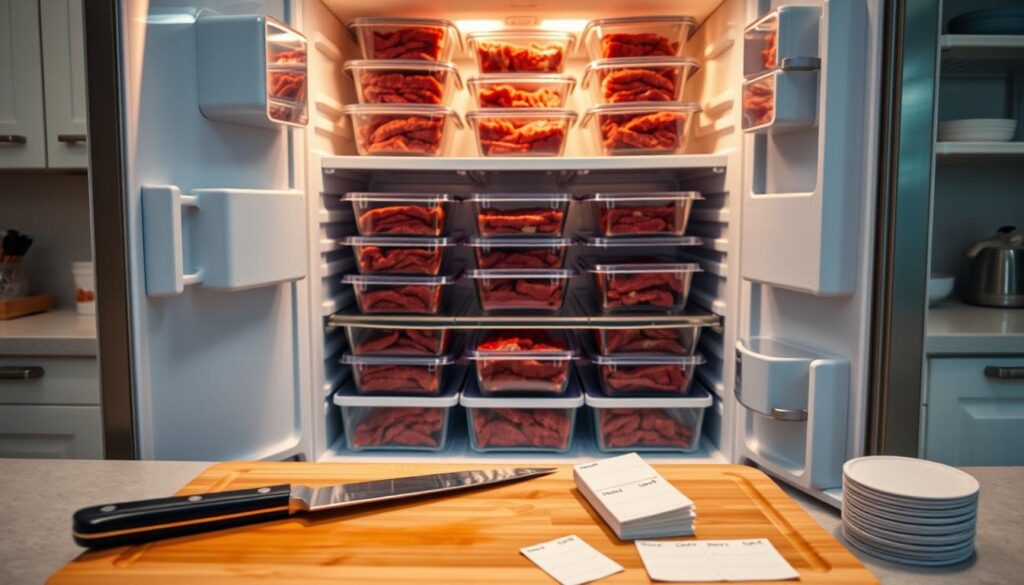
Creative Ways to Use Leftovers
Transforming leftover beef into new dishes prevents waste and creates varied meals. Medium well beef is more thoroughly cooked, making it versatile for leftovers. You can dice it for a hearty breakfast hash, add it to a savory breakfast burrito, or use it in sandwiches and salads.
For dinner reinventions, try beef stroganoff, beef fried rice, or quick beef tacos. Soups and stews also work well with leftover beef – add it toward the end of cooking to prevent it from becoming tough. When reheating, use gentle methods like steaming or brief microwave heating with a damp paper towel cover to prevent further moisture loss.
By adopting these strategies, you can enjoy your perfectly cooked beef while minimizing waste and exploring new culinary possibilities.
Safety Tips When Cooking Beef
To enjoy your medium well beef safely, follow proper food handling and cooking techniques. This means understanding and using safety practices from start to finish. This includes when you shop and store your beef.
Food Safety Essentials
Start with safe practices when handling beef. Choose beef that feels cold and has no bad smells. Put it in your cart last and refrigerate or freeze it right away.
Store raw beef on the bottom shelf of your fridge. This helps prevent cross-contamination from drips.
Safe thawing practices are key. Thaw frozen beef in the fridge, taking about 24 hours for every 4-5 pounds. For quicker thawing, use cold water, changing it every 30 minutes. Microwaving is okay if you cook the beef right after.
Proper Cooking and Storage Temperatures
Knowing temperature guidelines is vital for food safety. The “danger zone” of 40°F to 140°F is where bacteria grow fast. So, it’s important to keep your beef out of this range.
Keep your fridge at or below 40°F (35-38°F is best) to slow bacteria. Freezers should be at 0°F or below for long-term storage. Cook beef to 150-155°F for medium well, which is safer than the USDA’s 145°F minimum.
After cooking, serve beef quickly or keep it hot if you’re late. Refrigerate leftovers within two hours (one hour in hot weather). Reheat leftovers to 165°F to kill bacteria.
Cooking for Different Interests
Grilling for a few or a crowd means knowing how to cook for everyone’s taste. It’s important to understand how to cook steaks to different doneness levels. This way, every guest gets their steak just right.
Accommodating Guests Who Prefer Different Doneness
One good way to cook for different tastes is the “staged cooking” method. Cook all steaks at once but take them off the heat at different times. This ensures each steak is cooked to the perfect doneness.
Start by letting all steaks come to room temperature. Then, cook them on high heat to get a nice crust. Use a thermometer to check the internal temperature. Remove rare steaks first, then medium rare, medium, and lastly medium well.
The “butterfly method” is great for thicker steaks. It cooks them faster and keeps them juicy. This is perfect for those who like their steak medium well.
| Doneness Level | Internal Temperature (°F) |
|---|---|
| Rare | 120-125 |
| Medium Rare | 130-135 |
| Medium | 140-145 |
| Medium Well | 150-155 |
Customizing Preparations for Personal Preference
Customizing steak preparations goes beyond knowing the right temperatures. It’s about considering how to keep the steak moist. This is key for those who prefer their steak medium well.
Brining the steak in a salt solution before cooking helps keep it moist. For leaner cuts, larding or barding with fat adds moisture during cooking.
For health-conscious diners, choose lean cuts like sirloin or tenderloin. Grill or broil them to drain excess fat. Consider special diets too. For low-carb or keto, use high-fat cuts and butter-based sauces. For low-sodium, use herbs instead of salt.
Exploring Global Beef Dishes
Global cuisine offers a wide range of beef dishes cooked to perfection. Often, this means the beef is cooked to a medium well. Each dish has its own flavors and cooking techniques.
International Dishes Featuring Medium Well Beef
Beef cooked to medium well is common in many cuisines. In Italian cuisine, tagliata is a sliced steak served over arugula with Parmesan and balsamic reduction. It’s cooked medium well to absorb flavors.
Mexican carne asada involves marinating thin cuts of beef in citrus and spices before grilling them to medium well. This develops the marinade’s flavors in the meat.
Korean bulgogi features thinly sliced beef in a sweet-savory marinade. It’s cooked to medium well on tabletop grills, creating complex flavors. In Chinese cuisine, beef with broccoli uses medium well beef to stand up to the sauce without becoming tough.
Middle Eastern kofta—spiced ground beef formed around skewers and grilled to medium well—ensures food safety while developing aromatic spices.
| Dish | Cuisine | Cooking Method | Doneness |
|---|---|---|---|
| Tagliata | Italian | Grilling | Medium Well |
| Carne Asada | Mexican | Grilling | Medium Well |
| Bulgogi | Korean | Grilling | Medium Well |
| Beef with Broccoli | Chinese | Stir-frying | Medium Well |
| Kofta | Middle Eastern | Grilling | Medium Well |
How Cooking Methods Differ Globally
Cooking techniques for achieving the ideal beef medium well temp vary across culinary traditions. In Argentina, asado cooking involves slowly grilling beef over wood coals at varying distances from the heat source. This allows for precise control to reach medium well while developing smoky flavors.
Japanese teppanyaki cooking uses a flat iron griddle at carefully controlled temperatures. This achieves medium well doneness with a distinctive sear.
Brazilian churrasco employs rotisserie-style cooking over open flames. Constant rotation ensures even cooking to medium well while basting maintains moisture. In Morocco, tagine cooking uses low, moist heat to slowly bring beef to medium well in a sealed environment. This concentrates flavors and tenderizes through steam.
Exploring these international preparations offers new techniques and flavor combinations. They work well with medium well beef, expanding your culinary repertoire. By understanding and adapting these global cooking methods, you can achieve the perfect beef medium well temp in your own kitchen.
Conclusion: Enjoying Your Perfectly Cooked Beef
Learning to cook a medium steak to perfection is all about mastering temperature and technique. The key is to aim for a temperature of 150-155°F for the perfect medium well.
As you explore cooking beef, remember that science is the base, but your personal touch makes it art. Try different cuts and cooking methods like grilling or pan-searing. This can lead to discovering new favorites. Knowing the difference between medium rare (130-135°F) and medium well can really boost your skills.
Key Takeaways for Success
To always get your beef just right, focus on preparation, temperature, and resting. Use a good digital thermometer and remove the beef when it’s at the right temperature. This ensures the best results.
Embracing Your Culinary Journey
As you get better, don’t be afraid to try new things and global cooking styles. Investing in quality tools and connecting with other cooks can make your experience even better. By combining science and art in cooking beef, you’ll find a truly rewarding journey.
FAQ
What is the ideal internal temperature for medium well beef?
How do I know if my beef is cooked to medium well?
What are the best cuts of beef for cooking to medium well?
How long should I let my beef rest after cooking?
Can I cook beef to medium well in the oven?
What are some common mistakes to avoid when cooking beef to medium well?
How can I add flavor to my medium well beef?
What are some good side dishes to serve with medium well beef?
How should I store leftover medium well beef?
For more cooking tips, stay connected with us. We also recommend the cookbook Skinnytaste Simple: Easy, Healthy Recipes with 7 Ingredients or Fewer
For more Recipes about Steak ?
Did You try our recipe ?
There are no reviews yet. Be the first one to write one.
